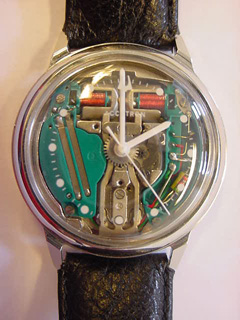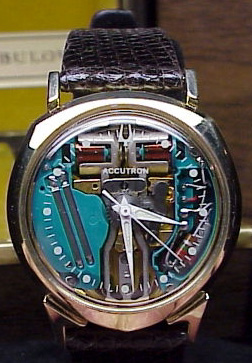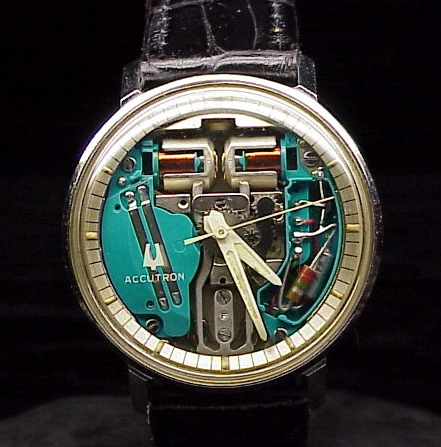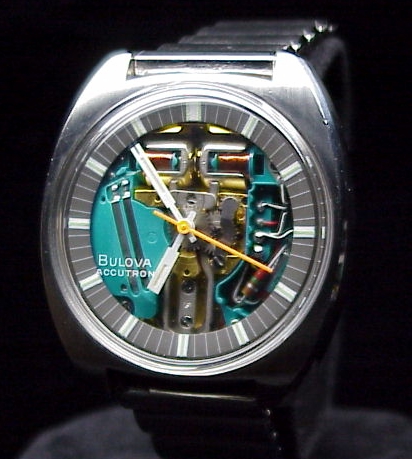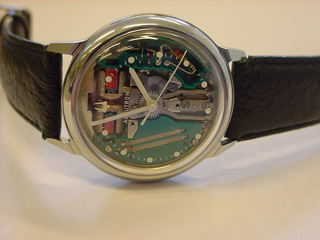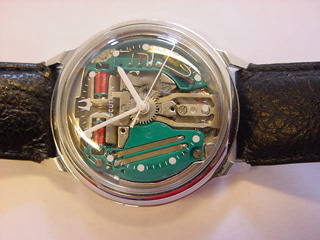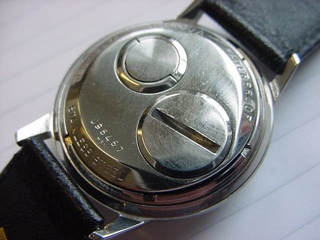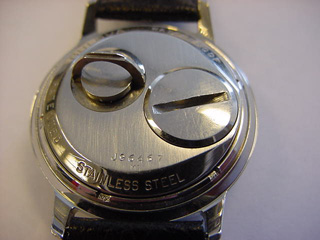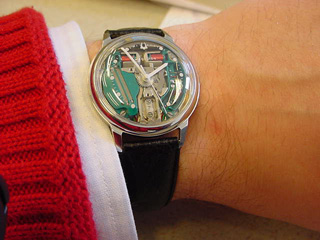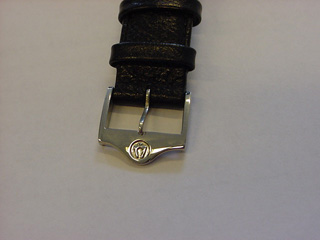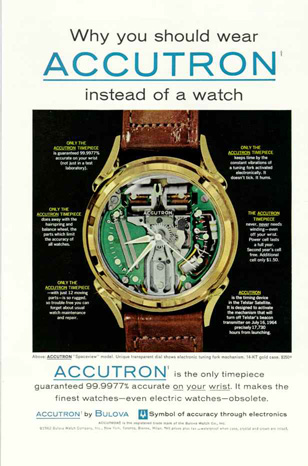Review : Bulova Accutron cal.214
Converted Spaceview
by Robert
Jan Broer
Voorburg/The Netherlands, 5th of May 2001
robertjan@omega-addict.com
www.omega-addict.com
In the 1950s, the days of mechanical watches only, companies started looking at other possibilities to design and produce accurate watches. It seems that chronometer specifications weren't accurate enough, or maybe too expensive for a lot of companies. One of these companies developed the Accutron movement, an electrical movement that used a tuning fork and that was powered by a battery. Another companies known for their electronic watches were Junghans (today known for the "radio controlled" watches and their Bundeswehr watch) and Hamilton. The inventor of the tuning fork watch, Max Hetzel, developed the first tuning fork system in 1953 (see here), but the components for a complete watch were not available at that time. After some prototypes (1st one in November 1954 at 240hz) and a transfer of the Bulova Accutron research & development department from Biel/Switzerland to New York/USA, Bulova finally showed their first Accutron watch to the public on the 25th of October 1960. The watch had the caliber 214 movement, which was used in the first years of production. Pieter Doensen, a Dutch watchcollector, has written a book called "Watch" which has dedicated some chapters to tuning fork watches. You can find a short overview on Accutron movements at "Tuning Fork watches" by Pieter Doensen. You can find a lot of information about the Bulova Accutron on the web, so I will include some links to Bulova website/homepages at the end of this review. Spaceview The most well known models of the Bulova Accutron watches are probably the Astronaut and the Spaceview. The Astronaut is the least confusing model, since there was only one model available (in several flavors ofcourse), as shown below.
The model above was very populair, especially amongst US pilots during the Vietnam war. As you can see, it has an extra hand, for adding an extra timezone. Mind that the secondhand of the watch is close to the minutehand. Since my watch is a Spaceview, and the chaptername is 'Spaceview', I will continue with the Spaceview models. ;-) The Spaceview watch comes in different flavours, besides my version (which is 'converted', but I'll come to that later) there are several others :
The Spaceview was available in steel, gold-plated and solid gold. In my quest for a Spaceview, I noticed that there are a lot of different versions and combinations of the watch. People even talk about 'conversions', which I mentioned before. A 'converted' Spaceview is a Bulova Accutron that wasn't sold as a Spaceview but as a 'normal' Bulova Accutron watch. With a normal dial. Jewelers (and maybe Bulova too) couldn't handle the demand for the Spaceview and started converting regular models to 'Spaceview' models. Removing the dial and placing another crystal and hands. The number of websites and homepages show how popular this watch was, and still is. The watch isn't very populair in Europe, but most American watchcollectors have at least one in their collection. Finally, the review My quest for a Spaceview didn't take very long. Just type in "Accutron Spaceview" at eBay (the online auctionhouse) and you will get a very long list of these watches that can be bought by placing the highest bid. Since I didn't mind having a 'converted' model, I just bid on the nicest affordable model that was auctioned at that moment. The internet was almost the only chance for me to buy an Accutron, since they are not very common watches in The Netherlands. I rarely see them on watchfairs, and when they have a Spaceview or Astronaut, the condition is in most cases quite bad. Scratches all over or even not running. Good Accutrons are more expensive here than in the US, even when you include shipping and extra costs (BidPay/CreditCard etc). When I received the watch I was amazed. It looked like new. It had some tiny scratches on the caseback but the case itself looked very nice. I noticed that the case had been polished, because there was an inscription on the back which can be seen if you look from certain angles. However, I couldn't care less about polishing (on this watch) and for the money, it's a fabulous piece of horological history. The first thing I did ofcourse, was put the watch to my ear, and listen to the humming sound of the movement...
As you can see, a nice round Spaceview model. Personally, I think this is one of the nicest models of the Spaceview watches. The roundcase makes it a bit timeless, and thus wearable in the '00s. The watch has a diametre of 35mm, which makes it quite small in comparison to the current standard on watches. However, it suits me perfectly.
The typical caseback of a cal.214 Accutron watch, so not only Spaceviews look like this. The big round thing is ofcourse for the battery, which is getting hard to find. These watches (with cal.214) were originally designed for use with Mercury 1.35 volts batteries. However, these are all gone. Most cal.214 watches use Silver Oxide batteries of type 387S. Please check this battery primer to see which batteries should be used now. You probably already noticed that the watch lacks a crown for setting/correcting time. At the left of the battery, you see another round disc. This is the 'hidden' crown of the watch. See the next photo for a 'better' view.
You can easily pull the crown up by using your fingernails. Now, you can correct the time. On the bottom of the caseback, you see a number. This is probably the serialnumber, I don't know exactly. Below that, you can hardly see it on the picture, there is a small engraving which says 'M3'. This is to ID the year of production. 'M' stands for the 1960s, and 'N' for the 1970s. Mine says 'M3', and means it is dated 1963. 'M7' would be 1967 and 'N1' would be 1971.
To make the watch complete, I added an original Bulova leather strap and buckle. For less than 15 USD. How about that? People also wear these watches with green lizard straps, brown croco straps and bracelets. However, I prefer a strap on this watch. The accuracy of this watch is better than any of my mechanical watches, that is also what Bulova promised back in the day. I didn't measure it, because I don't care really much if it is 1 second a week or 5 seconds a week. In my opinion, it is not a very pretty watch. But since it has some horological value, it is nice to add one to your collection. I also doubt that this watch is suitable for daily use, since the movement is very sensitive. I have to add, that this watch can be worn daily, but you have to be carefull. Take it off for a game of golf or when you are going to use your mountainbike. However, the Apollo spacecrafts in the 60s and 70s used Accutron boardclocks. The populairity of this watch in the USA was really unheard-of. People are really getting excited when they talk about these watches. Below is a quote from a message posted at a TimeZone messageboard : (The message was posted by Mark Polakoff) Robert, I've think we've determined that you were born in 1977 so I've got an Accutron story to tell you that predates your birth by a number of years. In 1965 I was in the United States Navy stationed about 50 miles North of San Francisco, that's where I live now and that's how I came to live here. One day while window shopping on Market Street I went into a small jeweler who was selling the revolutionary new watch, the Accutron. I purchased one of the first Accutron watches on the market - I wish I knew the model number but it was "very plain" no frills but it had that beautiful 60hz "hum". I bought the watch on time and paid $8.00 per week until I'd paid off the fantastic sum of (I think) about $120.00. In 1967 I was serving aboard an aircraft carrier off the coast of Viet Nam when my pride and joy was virtually crushed in a shipboard accident. I gathered all the pieces up and mailed them home to my Father with the hope he could send it off to Bulova to be fixed. In the mean time I had to have another Accutron. An American aircraft carrier is like a small city, mine had 5,000 men. We had a store and in the store was a brand spanking new Accutron Astronaut, it was about $160.00 in that day and age. I bought it and kept it for about 30 years. Oh, my Dad was able to get my first Accutron fixed and I kept it also. Those were my first two "good" watches. In a weak moment a few years ago I traded both those watches for two 1938 Hamilton tank watches. Enjoy your space view.. There is a lot of information you can find about these Spaceviews and other Accutron models. Old National Geographics magazines have nice adverts in them which tell you how things work, like this one below :
The advert tells you it is 99.9977% accurate (on the wrist), which was revolutionairy those days. Also the fact that a lot of famous people wore an accutron probably did the job. Scott Carpenter (astronaut Mercury) for instance, wore one.
I found the following websites/homepages extremely usefull doing research before I bought this watch (and fun to read) : Direct
Drive: The remarkable Bulova Accutron caliber 214 (by Walt Odets)
- this is the best illustrated explanation I have ever seen. I almost forgot to tell, but there are some other brands who used the Bulova movements as well. Take a look at the vintage models from Omega. They had tuning fork movements in every range of their products. Omega Geneve, Constellation, Seamaster and Speedsonic (Speedmaster-family). Omega even produced a MegaSonic watch, which was running at 720hz. If I am not mistaken, Omega used this movement only a few years, starting in 1970. There are two type of movements available, one with day and one with day-date.
And at the end... The only thing that I am left to say is that you should buy one if you haven't got one already. It is an important timepiece. Prices vary heavily, but be carefull when buying one. If it is broke, it can't be fixed easily. It will take a lot of time looking for a watcmaker who can, and who can find the right parts. You can only trust a watch when running and when it looks to be in a good optical condition. Never buy a tuning fork watch without haven't seen it running. If you have any questions/suggestions/comments, please mail me at : robertjan@omega-addict.com Best regards, Robert Jan Broer Note : Thanks to Chuck Maddox and Craig Joseph Poff for proof-reading it and point out some minor errors.
|
|||||||||||||||||||||||
|
|
